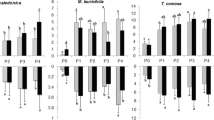Summary
Through Mo fertilization and N or P or NP enrichment, cultures of inoculant algaT. tenuis were prepared in situ in a rice-growing clay loam. The pattern of distribution of total, organic and mineral N was studied during the physiological stages of tillering, inflorescence and harvest stages of rice with particular reference to Mo-fertilized soils. Mineralisation sequence was studied in the postharvest stage also upto 250 days including the life span of the rice plant.
Though effect of fertilizer was generally more prominent than that of algalization, the latter in Mo-fertilized soils, could signify substantially higher mineral N, and also the low mineralisable index of N, a phenomenon very much desirable for slow release of soil reserve. A typical curve of soil N pattern possesses maximal level at tillering with levelling off at the harvest stage, but the curve of soil N pattern under algalization in Mo-fertilized soils was a hyperbolic one, having a maximal value at tillering.
There was no substantial N addition in control soils with or without alga. Algalization became effective only in Mo-fertilized soils upto 24–29% at tillering and 40% at blooming. Algalization with P or NP application in Mo-fertilized soils caused a 50% rise in the organic N. Sustenance of levels of both total and organic N beyond the tillering stage was a characteristic feature of algal inoculation.
Similar content being viewed by others
Bibliography
Bartholomew, W. V., Mineralisation and immobilization of nitrogen in the decomposition of plant and animal residues. Soil Nitrogen, Am. Soc. Agron. Ser. Agron.10, 287–302. (1965).
Bremner, J. M., Determination of total N by semikjeldahl method. Methods of Soil Analysis, Part2. Am. Soc. Agron. Inc. Madison, Wisconsin, U.S.A., 1171–1173. (1965).
Bremner, J. M., Determination of exchangeable (amm nitrate + nitrate) — N by MgO Devarda's alloy method. Methods of Soil Analysis, Part 2. Am. Soc. Agron. Inc. Madison, Wisconsin, U.S.A., 1195–1198 (1965).
Duncan, D. B., Multiple range and multiple F tests. Biometrics11, 1–42 (1955).
Fogg, G. E., Studies on nitrogen fixation by blue-green algae. 1. Nitrogen fixation byMabaena Cylindrica Lenn. J. Exp. Biol.19. 78–87 (1942).
Jansson, Sven L. 1958. Tracer studies on nitrogen transformation in soil with special attention to mineralisation-immobilization relationships. Kungl., Lant-brukshogskolans. Ann.24, 101–361 (1958).
Jensen, H. L., 1965 Nonsymbiotic nitrogen fixation. Soil Nitrogen, Am. Soc. Agron. Ser. of Agronomy 10, 436–488 (1965).
Keeney, D. R., and Bremner, J. M. 1966, Comparison and evaluation of laboratory methods of obtaining an index of soil nitrogen availability. Agron. J.58, 498–503 (1966).
MacRae, I. C. and Castro, T. F., Nitrogen fixation in rice soils. Soil Sci.103, 277–279 (1966).
Mehrotra, O. N., Sinha, N. S., and Shrivastava, R. D. L., Studies on the nutrition of Indian cereals. II Uptake of nitrogen and phosphorus at different stages of growth by early paddy (unhulled rice) under varying fertilizer management. Plant and Soil.27, 422–430 (1978).
Okuda, A., Yamaguchi, M., and Kobayashi, M., Nitrogen fixing microorganisms in paddy soils. IV nitrogen fixation with photosynthetic bacteria (Rhodopseudomonas capsulatus species) under various conditions. Soil and Plant Food5, 73–76 (1960).
Okuda, A., Yamaguchi, M., and Kobayashi, M., Nitrogen fixing microorganisms in paddy soils. V. Nitrogen fixation in mixed cultures of photosynthetic bacteria (Rhodopseudomonas capsulatus species) with other heterotrophic bacteria. Soil and Plant Food6, 35–39 (1960).
Quastel, J. H., Soil metabolism. Ann. Rev. Plant Physiol.16, 217–236 (1965).
Racho, V. V. and De Datta, S. K., Nitrogen economy of cropped and uncropped flooded rice soils under field conditions. Soil Sci.6, 419–426 (1968).
Russell, E. J., Soil Conditions and Plant Growth. Longmon's green and Co. London. p. 164 (1954).
Shields, L. M., and Durrell, L. W., Algae in relation to soil fertility. Botch. Rev.30, 93–128 (1964).
Smith, C. A. B. 1966. Biomathematics, Vol. I. Charles Griffin and Co. London (1966)
Venkataraman, G. S., The role of blue-green algae in agriculture. Science and Culture27, 9–13 (1961).
Watanabe, A., Distribution of nitrogen fixing blue-green algae in various areas of South and East Asia. J. Gen. Appl. Microbiol. (Tokyo)5, 21–29 (1959).
Watanable, A., Nishigaki, S. and Konishi, C., Species ofTolypothrix are very active nitrogen fixers. Nature168, 748 (1951).
Wolfe, M., The effect of molybdenum upon nitrogen metabolism ofAnabaena cylindrica. I. A. Study of the molybdenum requirements for nitrogen fixation and for nitrate and ammonia assimilation. Ann. Botany18, 299–308 (1959).
Wolfe, M., The effect of molybdenum upon nitrogen metabolism ofAnabaena cylindrica II. A more detailed study of the action of molybdenum in nitrate assimilation. Ann. Botany18, 309–325 (1959).
Author information
Authors and Affiliations
Rights and permissions
About this article
Cite this article
Chopra, T.S., Dube, J.N. Changes of N content of a rice soil inoculated withTolypothrix tenuis . Plant Soil 35, 453–462 (1971). https://doi.org/10.1007/BF01372678
Received:
Issue Date:
DOI: https://doi.org/10.1007/BF01372678




